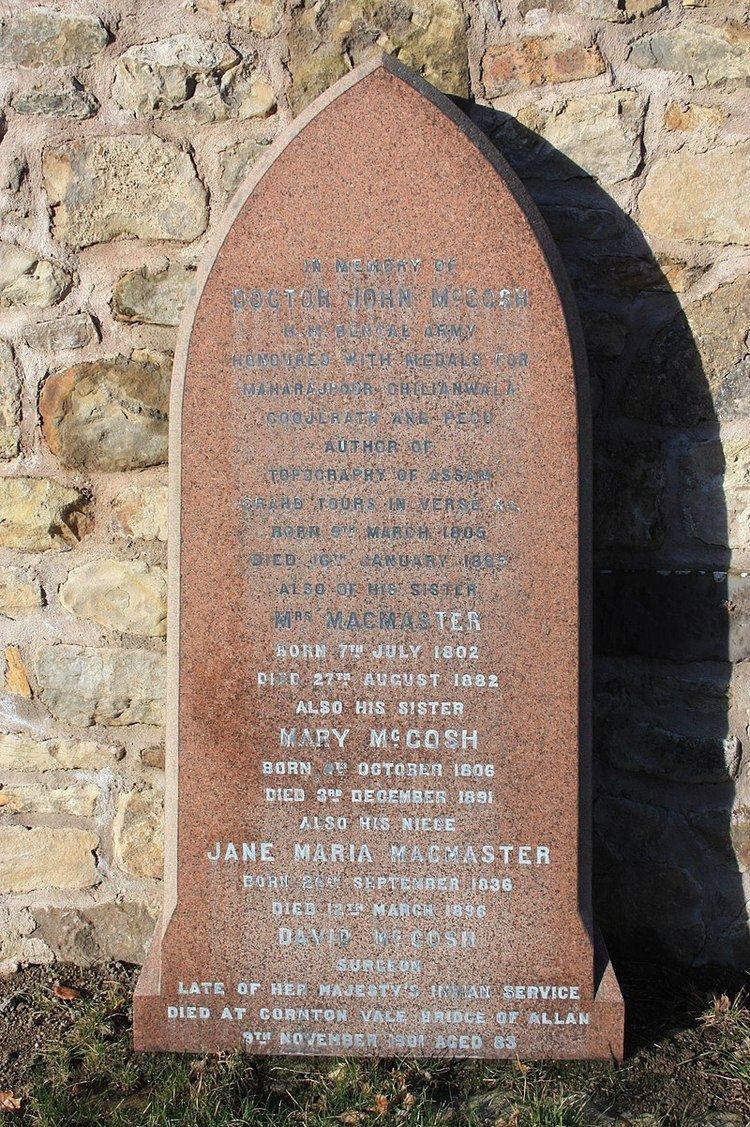Name John McCosh | ||
 | ||
John McCosh or John MacCosh or James McCosh (Kirkmichael, Ayrshire, 5 March 1805 – 18 January / 16 March 1885) was a Scottish army surgeon who made hobbyist photographs whilst serving in India and Burma. His photographs during the Second Anglo-Sikh War (1848–49) of people and places associated with the British rule in India (for which he is best known), and of the Second Burmese War (1852–53), count as sufficient grounds, some historians maintain, to recognise him as the first war photographer known by name. McCosh wrote a number of books on medicine and photography as well as books of poetry.
Contents
- Life and work
- Publications by McCosh
- Publications with material about McCosh
- Exhibitions with contributions by McCosh
- Collections
- References

Roddy Simpson has written of McCosh's photographs that "Given the circumstances, these images are a considerable achievement and, regardless of artistic merit, are historically very important". Taylor and Schaaf have written that "McCosh fashioned compositions that were exceptional for the period" and that unlike his contemporaries "in his hands, photography was not merely a pastime but became the means of recording history."
Life and work
In 1831, aged 26, McCosh became an assistant surgeon in the Indian Medical Service (Bengal), in the army of the East India Company, and served with its Bengal Army.
He saw active service on the north-east frontier of India against the Kol people in 1832–1833.
On 11 October 1833, on sick leave with a tropical disease, the barque on which he was sailing from Madras to Hobart in Tasmania, Australia, was wrecked off the desolate and remote Amsterdam Island in the southern Indian Ocean. Of the 97 people aboard, 21 survived, with McCosh the only surviving passenger. They were rescued on 26 October by a US sealing schooner, General Jackson, and taken to Mauritius. He wrote a book describing his experience, Narrative of the Wreck of the Lady Munro, on the Desolate Island of Amsterdam, October, 1833 (1835).
In 1840 / 1841–1842 he returned to Edinburgh for further training as a surgeon, studying military surgery, surgery and medical jurisprudence at Edinburgh University.
In 1843 McCosh returned to India as assistant surgeon with the 31st Bengal Native Infantry, taking part in the Gwalior Campaign and its battle of Maharajpur on 29 December 1843. He was awarded the Gwalior Star for Maharajpoor. McCosh began producing photographs either in 1843 or 1848.
He was sent to Almora, in the foothills of the Himalayas, and to Jalandhar in the Punjab.
In 1848 in the Punjab, he took part in the Second Anglo-Sikh War (1848–49) with the 5th Battery, Bengal Artillery / 2nd Bengal European regiment, where he was full surgeon. He saw active service in Yangon (known by the British as Rangoon) and Prome. Mostly his photographs were portraits of fellow officers, key figures from the campaigns, administrators and their wives and daughters, including Patrick Alexander Vans Agnew, Hugh Gough, 1st Viscount Gough; the British commander General Sir Charles James Napier; and Dewan Mulraj / Mul Raj, the Diwan (governor) of the city of Multan (a key leader of the Sikh nation against the British). He also photographed local people and architecture. His prints from this period measure no larger than 10 cm × 8 cm and were likely made from a quarter-plate sized camera.
He was in Burma (now known as Myanmar) during the Second Burmese War (1852–53) where he made portraits of colleagues, captured guns, temple architecture in Yangon and Burmese people, using a larger and heavier camera and producing larger prints. According to Taylor and Schaaf, Mccosh was there in a "quasi-official capacity to photograph during that conflict". His prints from this period are up to 20 cm × 22 cm, suggesting a camera measuring a whole plate in size.
McCosh took the first photographs of the Sikh people and palaces of Lahore; the earliest known photograph of Samadhi of Ranjit Singh in 1849; his fifty photographs of Burma from 1852 are the earliest images of the country to have survived; and his were the earliest studies of Burmese people.
McCosh predominantly used the calotype process for his photography, the first practicable negative and positive process, using paper, patented by Henry Fox Talbot in 1841. This process produced a translucent original negative image, a paper negative, from which multiple positives could be made by simple contact printing. McCosh also used the later collodion process though continued with the caltype process for larger prints because of its fidelity.
He gave up photography either in the early 1850s, or as late as 1856. He retired from the army on 31 January 1856. He became a fellow of the Royal Geographical Society in 1862. He died in London in 1885.
Roddy Simpson, in The Photography of Victorian Scotland (2012), wrote of McCosh that "these photographs do not have significant aesthetic quality but show the desire to document likenesses. Given the circumstances, these images are a considerable achievement and, regardless of artistic merit, are historically very important". Taylor and Schaaf, in Impressed by Light: British Photographs from Paper Negatives, 1840–1860, wrote that "McCosh fashioned compositions that were exceptional for the period" and that unlike his contemporaries "in his hands, photography was not merely a pastime but became the means of recording history." Taylor and Schaaf have also written that "the kind of work done by McCosh, [John] Murray and [Linnaeus] Tripe was echoed in a wide pattern of photographic activity throughout India, and in many ways these three can be regarded as role models to whom others looked for inspiration." ... "Few photographers in the calotype era came close to matching the sustained output of these three, and in visual sensitivity and technical bravado they remain unequalled."
